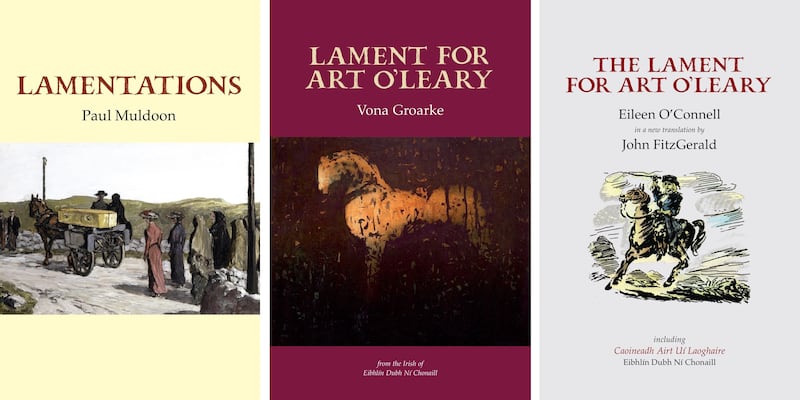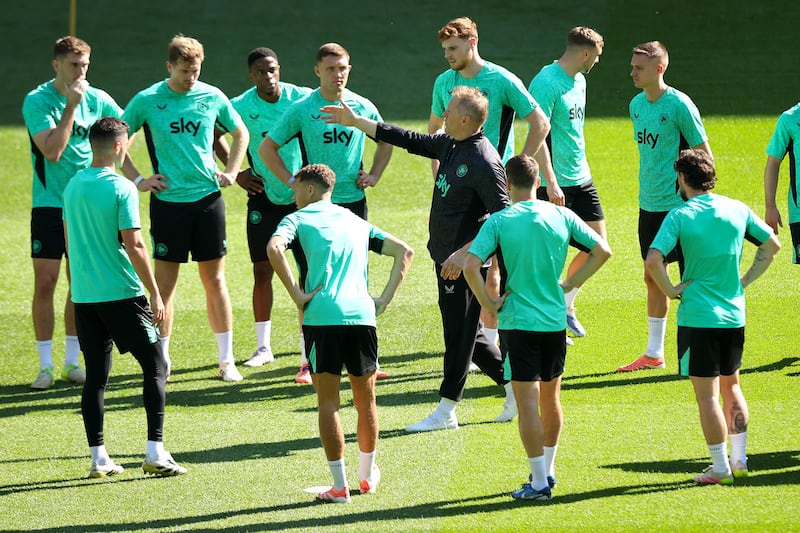It’s unusual for a poem to have an exact date of composition. In the case of Caoineadh Airt Uí Laoghaire, or Lament for Art O’Leary, we know it to have been May 4th, 1773, the date when Eibhlín Dubh Ní Chonaill’s husband, Art Uí Laoghaire, was murdered in Carriganimmy, in Co Cork, by officers acting on the orders of the local sheriff, Abraham Morris.
The nature of Art’s offence is not definitively recorded. Most likely it was a wrangle over his famous brown mare, a gift from Empress Maria Theresa to thank him for his service in her army, and worth far more than the £5 allowed to Catholics under the Penal Laws. The mare had beaten the sheriff’'s horse in a race, after which the smarting Morris demanded it be sold to him for the regulation sum, which Art understandably refused.
But Art – a wilful braggadocio, by all accounts – was probably in the habit of flouting other suppressive Penal Laws, and of rubbing up the authorities the wrong way. Certainly, Eibhlín’s family, the O’Connells of Derrynane – as close to Gaelic aristocracy as it was possible still to be in late-18th-century Ireland (Daniel was her nephew) – were none too pleased when she chose to elope with a man rather too used to drawing attention to himself than suited this politically circumspect family.
Eibhlín’s education would have rendered her well-versed in the forms and traditions of Irish poetry. She also would have attended local wakes at which professional keening women would have performed. She’d have known the craft and discipline and, clearly, was enough of a poet to apply them to her own personal tragedy. She performed the lament first over Art’s body as it lay by the side of the road and then again, that night, as he was being waked. It was memorised by Nóra Ní Shindile, one of the keening women present, who later recited it for a visitor, by whose good offices it was ultimately committed to writing. It remains one of the most extraordinary, vital and powerful poems we have.
RM Block
What is it about Eibhlín Dubh Ní Chonaill’s poem that caused Peter Levi to call it, in his inaugural lecture as Oxford professor of poetry, ‘the greatest poem written in these islands in the whole 18th century’?
Caoineadh Airt Uí Laoghaire/Lament for Art O’Leary exerts an ongoing fascination both in English translations and in its original Irish. Though the poem had been available in English translation since the end of the 19th century, Frank O’Connor’s poetic 1940 translation with Cuala Press, with six colour illustrations by Jack B Yeats, foregrounded its power and beauty. With Seán Ó Tuama’s 1961 version, the poem became the focus of much dedicated scholarship, with Prof Angela Bourke’s watershed study of the poem being a highlight of volumes IV and V of The Field Day Anthology of Irish Writing. Profs Declan Kiberd, Gearóid Ó Crualaoich and Meidhbhín Ní Úrdail, among others, have also written beautifully about it and its world.
In the second half of the 20th century, writers including Eílís Dillon, Seamus Heaney, John Montague, Thomas Kinsella and Brendan Kennelly translated some or all of this poem. Though never really obscured, it has recently moved front and centre of the Irish poetry stage. In his 2016 collection, My Lord Buddha of Carraig Éanna, Paddy Bushe published a new translation, The Howl for Art Ó Laoghaire. In 2018-19, Paul Muldoon’s version of the poem was performed, with music composed by Jim Lockhart and played by Horslips, in Belfast and New York. And, in 2020, Doireann Ní Ghríofa’s prizewinning A Ghost in the Throat grafted a personal memoir on to her version of Eibhlín Dubh’s poem. The Derry poet Mícheál McCann has reframed the poem as a lament to a gay lover killed during the Troubles, and later this spring the Gallery Press will publish John FitzGerald’s The Lament for Art O’Leary.

Has any Irish or, indeed, any single 18th-century poem enjoyed so many afterlives?
What is it about Eibhlín Dubh Ní Chonaill’s poem that caused Peter Levi to call it, in his inaugural lecture as Oxford professor of poetry, “the greatest poem written in these islands in the whole 18th century”? And why does it remain such a vivid and powerful presence?
Caoineadh Airt Uí Laoghaire/Lament for Art O’Leary is Ireland’s touchstone love poem. As a poem by a woman, in Irish, informed by traditional form, it is also, hands down, one of our most important poems.
I too have had a go at making a version of it, published in 2008 as Lament for Art O’Leary. I hesitate to call it a translation, because it is as much a response to extant English translations as it is to the original. What I thought was missing from the available versions in English was a sense of Eibhlín as an embodied young woman, articulating via tradition a searing personal loss. Hers was a howl of rage, not soft-focused mourning but red-hot grief, expressed without temperance, politeness or reserve. What’s so striking about the poem is its fire and fury, but also the fact that this is combined with a rigorous observance of poetic form.

To the modern ear, strict adherence to form might seem to chafe with the notion of invested sincerity: since the confessionalist poets of the 1960s, we might expect extremes of feeling to beg release from formal constraints and to give the taming effects of full rhyme or metrical symmetry the slip. But Eibhlín’s lament, with its three-beat line and finely tuned sound patterning and refrain phrases, rings passionately true. I wanted to try to find an equivalent for that in English that would translate the intensity of Eibhlín’s keen as much as convey the poem’s sense of time and place.
We might expect extremes of feeling to beg release from formal constraints. But Eibhlín’s lament, with its three-beat line and finely tuned sound patterning and refrain phrases, rings passionately true
I cannot conceive of my “translation” as being in competition with any other: no one (other than Eibhlín herself) has any real claim to the poem. As translators we are passing through it only, trying our best to honour the words and the power of the poem. I possibly got something right in my version, and probably got things wrong too. Someone else will approach it differently, and make a different poem of it, in time. That’s all to the good and is, I feel, part of the beauty of the enterprise. Constructing my version, with all the English translations of it I could find spread out on a large table around me, felt like a conversation. I never intended to bellow over them or to shout them down: for me the act of translating always felt like a shared process (albeit with co-opted collaborators).
Because of the slight looseness of its origins (the fact that it wasn’t written down until well after Eibhlín had composed it), Lament for Art O’Leary seems to offer a little elbow room to those of us who want to strike slightly reimagined tones or half-tones in the poem. Each generation will get, I suspect, the version that seems to chime with its own preoccupations and concerns. Mine is, I suppose, a feminist version, celebrating desire and physicality, as well as the power and agency of rage. Other writers might emphasise other aspects, from the personal to the political; it says something about the poem that it seems able to accommodate us all.

This year marks the poem’s 250th anniversary: this week, to mark the occasion, Cambridge University is hosting a day-long symposium to explore its extraordinary heritage and abiding influence.
Lament: A Celebration will feature lectures, talks, music, film and poetry, honouring the Irish tradition of the caoin and the specific example of Caoineadh Airt Uí Laoghaire/Lament for Art O’Leary. Because the poem embodies so many strands of Irish culture and poetics, the symposium will also explore topics such as Irish mourning rituals, improvised poetry, questions of translation, public utterance and women’s poetic voices in the 18th century.
Cambridge Group for Irish Studies, which has been hosting talks and seminars for more than three decades, remains one of the most dynamic venues in Britain for the representation of topics relating to Irish history and culture
Among the speakers at the symposium, Prof Angela Bourke will discuss her 50-year relationship with the poem; the scholars Dr Rebecca Barr, Dr Seán Ua Súilleabháin and Prof Tríona Ní Shiochain will consider questions of historical context, gender representation and textual difficulty in the poem; and the poets Martina Evans, Mícheál McCann, Fran Lock, myself and Paul Muldoon will discuss its poetic heritage and issues around its translation and reception. The day will conclude with a short film by Marcella O’Connor and a premier performance of excerpts from Irene Buckley’s opera setting of the poem, as well as responses by music students at St John’s College, Cambridge, where I am currently writer-in-residence.
[ Irish women’s poetry: making and remaking historyOpens in new window ]
The symposium, supported by Culture Ireland, is presented by the Cambridge Group for Irish Studies, which has been hosting talks and seminars by Irish scholars for more than three decades and remains one of the most dynamic venues in Britain for the representation of a wide range of topics relating to Irish history and culture. Cambridge University is also rare among universities in the UK in offering modern-Irish classes (sponsored by a grant from the Irish Government) and in promoting Celtic studies and medieval Irish.
Although Cambridge University is not the only institution to honour the poem’s anniversary (Maynooth University will also run an Irish-language celebration of the poem on Saturday, May 6th, as part of its Arts & Minds Festival), its combined expertise in Irish language, history and culture, as well as in contemporary poetry and poetics, will facilitate the kind of conversations that scholars, poets and translators really ought to be having about a poem both so embedded in its particular historic moment and so enduringly, critically current.
Lament: A Celebration takes place on Wednesday, May 3rd, at Magdalene College, Cambridge, both in person and, with limited places, online, via Zoom. It is free to attend, but registration is required for the remaining places
Vona Groarke’s most recent book is Hereafter: The Telling Life of Ellen O’Hara, published by New York University Press





















